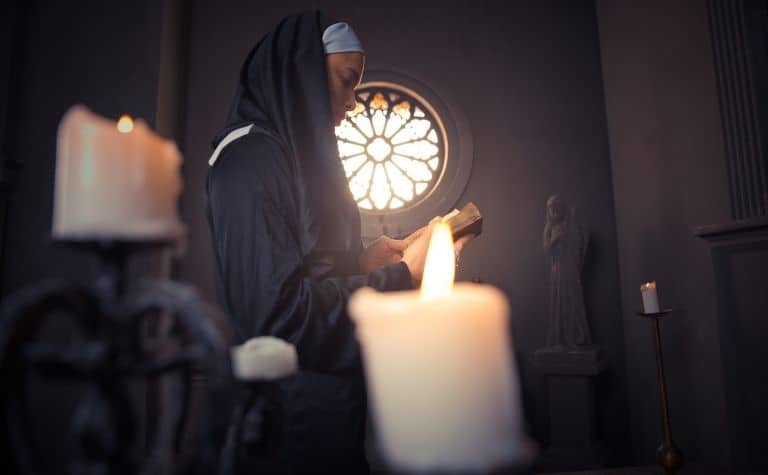When people imagine a nun, they often think about their black and white clothing, the vows of poverty and chastity the woman has made, and the Roman Catholic church. Are nuns only found in the Catholic church, or do Protestant churches have nuns, too?
In Protestant Christianity, Anglicanism is the tradition with the most nuns and the strongest and most developed system of religious orders. There are also a small number of nuns in the Lutheran and Methodist traditions as well. Protestant nuns are mostly found in Europe and Africa.
Why does Anglicanism have a stronger history with nuns than other Protestant traditions? How do Protestant nuns differ from Catholic nuns? How does a woman become a nun? Keep reading to learn more.

Does the Anglican Church Have More Nuns Than Other Protestants?
Many communities of nuns belong to the worldwide Anglican communion. This is a stark contrast to the earliest days of the Anglican tradition. (Also, see Protestant vs. Anglican: What’s the Difference?)
Early in the 16th century, King Henry VIII separated the Church of England from the authority of the Pope. As part of that separation, Henry abolished all religious communities.
For the next three centuries, with a few possible exceptions, no communities of nuns existed within the Anglican church because the role was closely associated with Catholicism.
Eventually, Anglican leadership decided that if a woman desired to become a nun, she had to do so within the Anglican tradition.
It wasn’t until the religious revival of the Oxford Movement in the 19th century that sustained interest in forming religious orders returned. [1] (Also see Here’s Why Protestants Reject the Authority of the Pope)
Today, there are over 3000 sisterhoods in the Anglican tradition. These communities vary in both structure and creed. However, one hallmark of these sisterhoods is an emphasis on serving the needs of the poor and less fortunate within society. (Also, see Why Don’t Protestants Make the Sign of the Cross?)
This contrasts the cloistered existence and contemplative nature of nuns during previous eras of the church. Nevertheless, inward-focused orders still exist.
Although this is not necessarily the case in the rest of the world, the Episcopal Church — a part of the Anglican tradition — distinguishes between a religious order and a religious community. (Also see Did Protestants Remove Books from the Bible?)
- Those belonging to a religious order focus on a spiritual connection with God and others apart from the normal society of the world. They take what is called traditional vows.
- Religious communities, on the other hand, look outward and serve any and everyone, often through education or medical care.
Nuns in the modern Anglican communion adhere to a variety of vows. Most of them take vows of chastity, although there are also orders which married people may also join.
- Some take vows of poverty and share property and money equally.
- Others are mendicant, meaning that they do not stay in one place but instead travel from place to place.
- Still, others live more traditional, individual Christian lives, except that they meet regularly to have community with one another and to serve others.

What Is the Purpose of Nuns In Catholicism As Opposed To Protestantism?
Unlike in Anglicanism, religious orders have never ceased to operate in the Catholic Church. For women, religious orders exist for two primary reasons. (Also see Why Don’t Protestants Believe in Transubstantiation?)
First, for those willing and able to remain unmarried, it provides a place and community to serve God in a focused and vigilant manner. Besides the authority of the Pope and the Church, Catholic sisterhoods draw support for their life from the pages of Scripture.
One important passage is 1 Corinthians 7:34, which says that unmarried women care for the things of the Lord, whereas married women care for the world since they are considering how they might please their spouses. “And the unmarried woman and the virgin are anxious about the affairs of the Lord, so that they may be holy in body and spirit; but the married woman is anxious about the affairs of the world, how to please her husband.” (1 Corinthians 7:34, NRSV)
Furthermore, an unmarried woman can pursue holiness in both body and spirit. This seems to fit well with the Apostle Paul’s teaching on marriage, who argues that it is better for a person to remain unmarried so that they might better serve God without distraction.
One way that nuns do this is through the keeping of the Office of the Hours, which is a liturgy of specific prayers to say throughout the day. (Also, see Protestant vs. Eastern Orthodox: What’s the Difference?)
Second, Catholic religious orders exist to serve the many needs of the surrounding world. For this reason, Catholic theology differentiates between nuns and sisters.
Nuns take solemn vows and cloister themselves within the walls of a nunnery to lead a contemplative life free from the concerns of the world.
Sisters, on the other hand, take a different set of vows that allow them to directly serve the needs of those around them. (Also see Do Protestants Believe in the Saints?)
Through the earthly vocation of nursing or education, nuns follow the call of God to be the hands and feet of Christ. By denying themselves earthly pleasures, nuns believe that they are better able to offer themselves to those around them. [2]

How Does a Woman Become a Nun?
The vows that nuns take require a significant commitment. Unlike the Anglican tradition, all Catholic nuns and sisters must take vows of chastity. Because of the commitment required, becoming a nun is a lengthy process. (Also, see Protestant vs. Pentecostal: What’s the Difference?)
The first step for a prospective nun is to partake in a testing period, during which nuns experience many of their future duties and obligations. This usually lasts six months to two years and ends with the woman receiving the habit or distinctive clothing of her particular order.
At this point begins the novitiate, which is an interim period of one to two years, during which time the woman fully partakes in all of the duties of being a nun. (Also, see Do Protestants Have Confession?)
If she satisfies the requirements of this step, she takes temporary vows, which last another one to three years. At the conclusion of the temporary vows, she may finally take her solemn vows.
Solemn vows often include three different vows.
- The first is the vow of stability, which means that a nun will remain committed to one religious community.
- The second is the vow of obedience, which means that she places herself under the authority of the abbess or whoever is in charge of that particular community.
- The third is the conversion of life, which is a vow of poverty in which the nun gives up all her possessions and chooses to live the communal life. [3]
References:
[1] Source
[2] Source
[3] Source
Related Questions
Catholic vs. Protestant vs. Orthodox: What's the Difference?
Roman Catholicism, Protestant Christianity, and the Eastern Orthodox Church are the three historical branches of the Christian religion. Each tradition traces its doctrines and practices to the New...
Protestantism and Anglicanism are branches of the Christian faith that have roots in Europe. Protestantism and Anglicanism have similarities and differences with each other as well as other...
